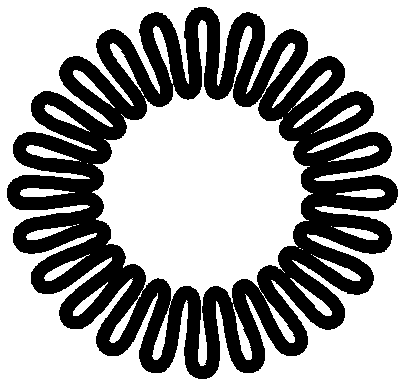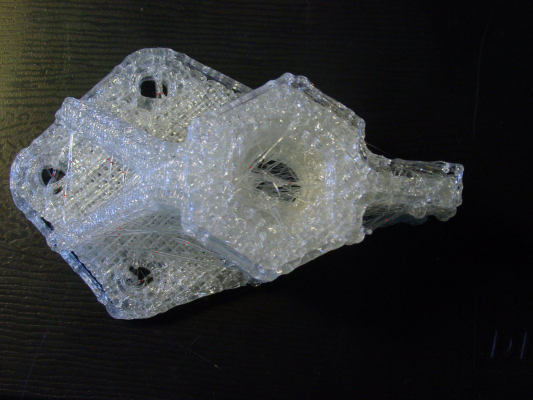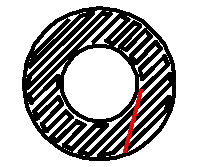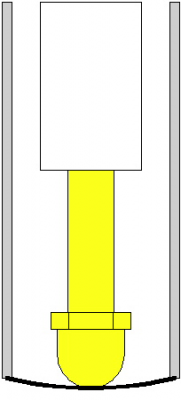Web Fighting
Posted by Assargadon
|
Web Fighting January 12, 2008 05:28AM |
Registered: 16 years ago Posts: 58 |
There is general problem with current layers filling alhorithm: vertical holes are always filled with strings of plastic, looking like some kind of "web". For example, it's picture from last posting in RepRap blog: [bp3.blogger.com]
As far as I understand, problem is plastic stick to toolhead instead of stiking to workpiece. Or, maybe, extrusion rate is not quick enought related to stiking to workpiece.
I think this effect can be abolished, if we modify border filling alhorithm. It's the illustration of filling the border of circular hole:
and same idea can be used for outer borders, for non-circular holes and so on.
What do you think? Is it idea usable?
As far as I understand, problem is plastic stick to toolhead instead of stiking to workpiece. Or, maybe, extrusion rate is not quick enought related to stiking to workpiece.
I think this effect can be abolished, if we modify border filling alhorithm. It's the illustration of filling the border of circular hole:
and same idea can be used for outer borders, for non-circular holes and so on.
What do you think? Is it idea usable?
|
Re: Web Fighting January 12, 2008 07:05AM |
Admin Registered: 17 years ago Posts: 7,879 |
The stringing is caused by the fact that, although you can stop the extruder, the filament is still attached and molten (because the nozzle is hot). When you then move the nozzle with the extruder stopped the molten filament stretches rather than snapping.
E.g. when I finish extruding my HDPE test objects I switch off the extruder, pause for a second and then go to maximum Z at full speed. That creates a very long thin thread. Once it has cooled you can snap it but while it is molten it will stretch almost infinitely. It probably drags molten material out of the nozzle to help to add to its length.
Your fill pattern would avoid it for that shape but you would still have one string when you end the object.
It is possible to make a cylinder without stringing with the conventional outline and zigzag fill, it just requires the s/w to avoid moving across the hole, but some shapes cannot avoid it. Consider, for example making, an upside down table, you cannot get from one leg to another without a string.
I think the way to prevent it completely is to have a solenoid operated blade at the end of the nozzle, or perhaps a high pressure blast of air.
Edited 2 time(s). Last edit at 01/12/2008 08:11AM by nophead.
[www.hydraraptor.blogspot.com]
E.g. when I finish extruding my HDPE test objects I switch off the extruder, pause for a second and then go to maximum Z at full speed. That creates a very long thin thread. Once it has cooled you can snap it but while it is molten it will stretch almost infinitely. It probably drags molten material out of the nozzle to help to add to its length.
Your fill pattern would avoid it for that shape but you would still have one string when you end the object.
It is possible to make a cylinder without stringing with the conventional outline and zigzag fill, it just requires the s/w to avoid moving across the hole, but some shapes cannot avoid it. Consider, for example making, an upside down table, you cannot get from one leg to another without a string.
I think the way to prevent it completely is to have a solenoid operated blade at the end of the nozzle, or perhaps a high pressure blast of air.
Edited 2 time(s). Last edit at 01/12/2008 08:11AM by nophead.
[www.hydraraptor.blogspot.com]
|
Re: Web Fighting January 12, 2008 09:31AM |
Registered: 16 years ago Posts: 447 |
|
Re: Web Fighting January 12, 2008 09:46AM |
Admin Registered: 17 years ago Posts: 7,879 |
Yes but if any cross section of your object forms separate islands the problem has no solution. The salesman needs a boat ;-)
In practice the strings are very thin so it is easy to remove them if you can get to them with a knife, drill, etc.
I wonder how the commercial machines handle it?
[www.hydraraptor.blogspot.com]
In practice the strings are very thin so it is easy to remove them if you can get to them with a knife, drill, etc.
I wonder how the commercial machines handle it?
[www.hydraraptor.blogspot.com]
|
Re: Web Fighting January 12, 2008 12:52PM |
Registered: 16 years ago Posts: 58 |
Let's look at this picture:
Red dots (it's good to look at full size) marks non-"very thin" thread. And there are lot of red dots on the picture. So, some other effect works here in addition to described one.
Red dots (it's good to look at full size) marks non-"very thin" thread. And there are lot of red dots on the picture. So, some other effect works here in addition to described one.
|
Re: Web Fighting January 12, 2008 01:13PM |
Registered: 16 years ago Posts: 58 |
By the way, if we talking about islands and boats, in most cases we can print every island separately maybe. If we talking about "upside down table", as far as distance between legs is big enought, we can print every leg separately. Of course, it not ALWAYS possible, but, I think, it's OFTEN possible. But it's theme for another topic.
So, if I understand correctly, proposed border fill pattern is useless?
So, if I understand correctly, proposed border fill pattern is useless?
|
Re: Web Fighting January 12, 2008 02:26PM |
Admin Registered: 17 years ago Posts: 7,879 |
I think Vic mentioned the thick strings in the picture are s/w bugs which can be fixed, i.e. the extruder was running when it crossed the holes.
The thin strings are where it crosses with the extruder off, I think. In this case it could be possibly fixed by clever s/w. However, even if the extruder sidestepped the holes to get from one side to another the filament may shortcut and still go through the hole.
Your border fill pattern makes the s/w simple for walled objects but, it has a problem in that the outer fill is less dense then the inner, and is not a general solution.
The standard fill pattern can make the same shape without any strings if it clever enough to follow the red path.
One of the big advantages with additive processes like FDM is that they can make almost any shape whereas subtractive processes cannot. That is because they work in layers. If you depart from that then you have the complicated problem of tool collision avoidance and limitations on what you can make.
Strings can be reduced by clever s/w but they can only be eliminated completely by a means of cutting off the thread. If we implement that mechanically the s/w stays simple and we have a 100% solution. If we don't the s/w gets very complicated and we still have some strings in some cases.
Edited 1 time(s). Last edit at 01/12/2008 02:32PM by nophead.
[www.hydraraptor.blogspot.com]
The thin strings are where it crosses with the extruder off, I think. In this case it could be possibly fixed by clever s/w. However, even if the extruder sidestepped the holes to get from one side to another the filament may shortcut and still go through the hole.
Your border fill pattern makes the s/w simple for walled objects but, it has a problem in that the outer fill is less dense then the inner, and is not a general solution.
The standard fill pattern can make the same shape without any strings if it clever enough to follow the red path.
One of the big advantages with additive processes like FDM is that they can make almost any shape whereas subtractive processes cannot. That is because they work in layers. If you depart from that then you have the complicated problem of tool collision avoidance and limitations on what you can make.
Strings can be reduced by clever s/w but they can only be eliminated completely by a means of cutting off the thread. If we implement that mechanically the s/w stays simple and we have a 100% solution. If we don't the s/w gets very complicated and we still have some strings in some cases.
Edited 1 time(s). Last edit at 01/12/2008 02:32PM by nophead.
[www.hydraraptor.blogspot.com]
|
Re: Web Fighting January 12, 2008 02:36PM |
Admin Registered: 17 years ago Posts: 7,879 |
PS, if you print each leg of the table separately you will still have one string attached to each leg, and it is only possible if the legs are wider apart than the nozzle radius and shorter than the nozzle length.
Edited 2 time(s). Last edit at 01/12/2008 02:38PM by nophead.
[www.hydraraptor.blogspot.com]
Edited 2 time(s). Last edit at 01/12/2008 02:38PM by nophead.
[www.hydraraptor.blogspot.com]
|
Re: Web Fighting January 12, 2008 07:13PM |
Registered: 16 years ago Posts: 235 |
nophead,
About the solenoid-knife, Iam just wondering if the blade physically cuts(perpendicular to thread) the thread or if it scrapes the extruder (parallel to thread) or a combination of the two (Angle)? And this blade would just sort of spin around perpendicular to the extruded filament?
What if you just used a wire that was tensioned enough to be able to cut the hot filament? Then a very small servo that costs 25 cents could be used. Tell me what you think.
Jay
About the solenoid-knife, Iam just wondering if the blade physically cuts(perpendicular to thread) the thread or if it scrapes the extruder (parallel to thread) or a combination of the two (Angle)? And this blade would just sort of spin around perpendicular to the extruded filament?
What if you just used a wire that was tensioned enough to be able to cut the hot filament? Then a very small servo that costs 25 cents could be used. Tell me what you think.
Jay
|
Re: Web Fighting January 12, 2008 07:44PM |
Admin Registered: 17 years ago Posts: 7,879 |
I have managed to break the filament with both a brush and a scalpel blade mounted on the table. When using the blade it was perpendicular to the filament.
A hot wire may well work. Even a cold wire moving tight across the nozzle tip would probably do it. The problem would be keeping it clear of the work piece.
The nozzle would have to lift (or the bed lower) by the width of the cutter before the cut and drop again for the next segment. Ideally it would lift no higher otherwise you would get a short vertical string. If it only lifts by the blade/ wire thickness then nothing can be below that so the wire would have to be self supporting.
Perhaps an L shaped piece of thin metal with a small hole in the bottom could come down the side of the nozzle and round the end. The hole would line up with the nozzle hole, so it would effectively become the end of the nozzle. Activating the solenoid would shift it sideways cutting the thread.
Somebody in the past suggested something like a camera iris at the end of the nozzle to control the filament width [forums.reprap.org]. You could also cut by closing the iris completely. I think that's probably too difficult to fabricate.
Maybe some sort of artificial sphincter. A loop of something that can expand to close off the hole.
[www.hydraraptor.blogspot.com]
A hot wire may well work. Even a cold wire moving tight across the nozzle tip would probably do it. The problem would be keeping it clear of the work piece.
The nozzle would have to lift (or the bed lower) by the width of the cutter before the cut and drop again for the next segment. Ideally it would lift no higher otherwise you would get a short vertical string. If it only lifts by the blade/ wire thickness then nothing can be below that so the wire would have to be self supporting.
Perhaps an L shaped piece of thin metal with a small hole in the bottom could come down the side of the nozzle and round the end. The hole would line up with the nozzle hole, so it would effectively become the end of the nozzle. Activating the solenoid would shift it sideways cutting the thread.
Somebody in the past suggested something like a camera iris at the end of the nozzle to control the filament width [forums.reprap.org]. You could also cut by closing the iris completely. I think that's probably too difficult to fabricate.
Maybe some sort of artificial sphincter. A loop of something that can expand to close off the hole.
[www.hydraraptor.blogspot.com]
|
Anonymous User
Re: Web Fighting January 13, 2008 12:59AM |
Do you think some future RepRap could be made that would first build up the 3D object and then a second head would mill all the voids of the object thereby removing all the threads?
Then again I am sure the RepRap of tomorrow will use multiple materials with each offering there own unique problem that will need to be solved.
Then again I am sure the RepRap of tomorrow will use multiple materials with each offering there own unique problem that will need to be solved.
|
Re: Web Fighting January 13, 2008 03:13AM |
Registered: 16 years ago Posts: 58 |
What about small loop of nichrome wire around the nozzle? If we heat it enought, it just burn out plastic string. It smells not very good, but easy and no mooving parts. Only problem is attaching this loop to nozzle.
All I really understnad that I need some kind of repstrap to play with. So my impatience with delivering increased all the time.
All I really understnad that I need some kind of repstrap to play with. So my impatience with delivering increased all the time.
|
Re: Web Fighting January 13, 2008 05:37AM |
Admin Registered: 17 years ago Posts: 7,879 |
Cheap,
Post milling is certainly feasible if your machine is stiff enough. HDPE seems to machine quite well. The problem is you can only mill the bits accessible from above. How would you tackle the horizontal hole through the extruder clamp for example?
I don't know whether stringing particularly relates to the material. CAPA, PLA and HDPE all seem to do it. I can't imagine how you could have a plastic that is molten enough to extrude but brittle enough to snap as soon as you try to stretch it.
[www.hydraraptor.blogspot.com]
Post milling is certainly feasible if your machine is stiff enough. HDPE seems to machine quite well. The problem is you can only mill the bits accessible from above. How would you tackle the horizontal hole through the extruder clamp for example?
I don't know whether stringing particularly relates to the material. CAPA, PLA and HDPE all seem to do it. I can't imagine how you could have a plastic that is molten enough to extrude but brittle enough to snap as soon as you try to stretch it.
[www.hydraraptor.blogspot.com]
|
Re: Web Fighting January 13, 2008 06:01AM |
Admin Registered: 17 years ago Posts: 7,879 |
Assargadon,
It might work, but there again it might need to be so hot it sets fire to the plastic.
Inspired by Jay, I am currently thinking along these lines:-
A wire stretched between two swinging arms that are sprung outwards. They are just a bit short so that they don't hit the work piece. The wire gets dragged over the acorn nut dome though.
The action would be to lift the nozzle by the wire diameter. Swing the arms across the nozzle end and then drop the nozzle again.
[www.hydraraptor.blogspot.com]
It might work, but there again it might need to be so hot it sets fire to the plastic.
Inspired by Jay, I am currently thinking along these lines:-
A wire stretched between two swinging arms that are sprung outwards. They are just a bit short so that they don't hit the work piece. The wire gets dragged over the acorn nut dome though.
The action would be to lift the nozzle by the wire diameter. Swing the arms across the nozzle end and then drop the nozzle again.
[www.hydraraptor.blogspot.com]
|
Re: Web Fighting January 13, 2008 09:27AM |
Registered: 16 years ago Posts: 235 |
|
Re: Web Fighting January 13, 2008 03:03PM |
Admin Registered: 16 years ago Posts: 13,886 |
... a problem could be carbonizing and oxydizing of the NiCr-wire, as there exhaust some organic acid, when overheating the plastic!
When i built my first laser-cutter, the little amaount of fume passed by the evacuating hose very fast rusted the metal-parts around the toolhead, so in the next version i made all my rods, bearings and supports from stainless-steel and delrin.
Another problem could be that all mechanical cutters (blades, wires, irises, ...) parts moving through the thread would be contaminated with the fluid plastic or oxides/carbon when overheating, so they should be coated with PTFE or another anti-adhesing coating, so you can't use them at higher temps then 300
When i built my first laser-cutter, the little amaount of fume passed by the evacuating hose very fast rusted the metal-parts around the toolhead, so in the next version i made all my rods, bearings and supports from stainless-steel and delrin.
Another problem could be that all mechanical cutters (blades, wires, irises, ...) parts moving through the thread would be contaminated with the fluid plastic or oxides/carbon when overheating, so they should be coated with PTFE or another anti-adhesing coating, so you can't use them at higher temps then 300
|
Re: Web Fighting January 14, 2008 06:05AM |
Admin Registered: 17 years ago Posts: 7,879 |
Yes, if we don't use a non adhesive cutter we may just end up with strings to the cutter instead of the nozzle.
PTFE coated nichrome wire seems ideal because the PTFE would also help the wire to glide over the dome.
So far I have not been able to find a source of small quantities. 5000ft is rather a lot for an experiment!
We may get away without heating it, in which case any thin wire with PTFE coating will do.
[www.hydraraptor.blogspot.com]
PTFE coated nichrome wire seems ideal because the PTFE would also help the wire to glide over the dome.
So far I have not been able to find a source of small quantities. 5000ft is rather a lot for an experiment!
We may get away without heating it, in which case any thin wire with PTFE coating will do.
[www.hydraraptor.blogspot.com]
Sorry, only registered users may post in this forum.



